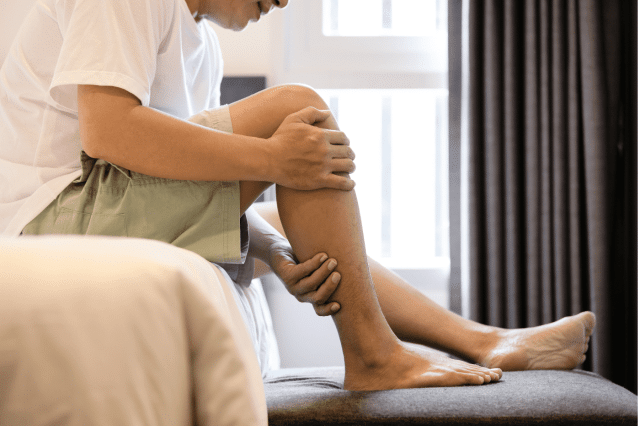
Leg pain can stem from various causes, ranging from minor injuries to serious circulatory issues, significantly impacting daily activities and overall quality of life. Proper diagnosis and understanding of the underlying reasons are crucial for effective vein treatment and management. If you are experiencing persistent or severe leg pain, schedule an appointment with the Vein & Skin Center of Hawaii today for expert evaluation and care.
Leg pain is a common experience, affecting people of all ages and activity levels. It can range from a mild annoyance to a debilitating ache that disrupts your daily routine. But what exactly is causing that pain in your leg?
This guide dives into the world of leg pain, exploring the various reasons behind this frustrating issue. We’ll examine how everyday activities, underlying medical conditions, and even the health of your circulatory system can all play a role in leg discomfort.
By understanding the root cause of your leg pain, you can take steps to find relief and get back to moving freely. This guide will equip you with the knowledge you need to identify potential culprits, understand when to seek medical attention, and explore preventative measures to keep leg pain at bay.
Understanding Leg Pain: An Overview
Our legs are the workhorses of our bodies. They carry us throughout the day, absorbing impact and propelling us forward. They house a complex network of arteries and veins, playing a vital role in circulation and overall health. So, when leg pain strikes, it’s more than just an annoyance – it’s a potential signal that something might be seriously wrong.
Leg pain can manifest in various ways, from a dull ache to a sharp pang. While the severity can vary, understanding the underlying cause is crucial. By identifying the culprit, you can take steps towards effective relief and ensure your legs continue to be the strong foundation for an active life.
How Is The Circulatory System Linked to Leg Pain?
The circulatory system plays a vital role in the health of our legs. It is responsible for delivering oxygen and nutrients to the muscles and tissues in the legs, as well as removing waste products. When there is a problem with the circulatory system, it can lead to leg pain.
Conditions that affect the circulatory system, such as peripheral artery disease (PAD) and deep vein thrombosis (DVT), can cause leg pain. PAD occurs when there is a narrowing or blockage of the blood vessels in the legs, leading to reduced blood flow. DVT, on the other hand, is a blood clot that forms in a deep vein, usually in the leg.
If you are experiencing leg pain that is accompanied by symptoms like swelling, numbness, or changes in skin color, it is important to seek medical attention to determine if there is an underlying circulatory issue.
Vascular Conditions That May Be Behind Your Leg Pain
Beyond the everyday aches and pains, leg discomfort can sometimes point to issues within your vascular system. These underlying conditions can significantly affect your health and daily life, limiting mobility and impacting your overall well-being.
Here are some of the most common vascular culprits behind leg pain:
- Varicose Veins: These are enlarged, twisted veins that appear bulging or rope-like just beneath the skin’s surface. They occur when the valves within the veins weaken, allowing blood to pool and flow backward instead of returning efficiently to the heart. This pooling can lead to a dull ache or throbbing pain, particularly in the calves and ankles. Other symptoms associated with varicose veins can include itching, burning, swelling, and skin discoloration.
- Venous Insufficiency: This condition arises when the veins in the legs struggle to pump blood back to the heart effectively. Similar to varicose veins, venous insufficiency can cause blood to pool in the legs, leading to a dull ache, throbbing, or cramping sensation. Commonly affecting the calves and ankles, the pain often worsens with prolonged standing or sitting and may improve with elevation. Watch out for additional symptoms like swelling, fatigue, and changes in skin texture or color.
- Deep Vein Thrombosis (DVT): This serious condition involves the formation of a blood clot within a deep vein, usually in the legs. DVT can be life-threatening if the clot breaks free and travels to the lungs (pulmonary embolism). While leg pain can be a symptom of DVT, it’s not always present. However, be on the lookout for sudden and unexplained swelling, redness, or warmth in one leg, particularly the calf. DVT can also cause tenderness to the touch and a feeling of heaviness in the affected leg. If you experience any of these symptoms, seek immediate medical attention.
- Peripheral Artery Disease (PAD): This condition develops when arteries supplying blood to the legs become narrowed or blocked due to plaque buildup (atherosclerosis). Restricted blood flow can cause pain, particularly in the calves, thighs, or buttocks, especially when walking or exercising. The pain typically eases with rest but returns with activity (claudication). Other symptoms of PAD can include numbness, tingling, coldness in the affected leg(s), and sores that heal poorly.
Remember, this list is not exhaustive, and consulting a healthcare professional is crucial for proper diagnosis and treatment of any suspected vascular condition.
By understanding the potential causes of leg pain and the warning signs associated with vascular issues, you can take a proactive approach to your leg health and address any concerns promptly.
When To Seek Medical Attention For Your Leg Pain
Leg pain is a common experience, and thankfully, many cases resolve on their own with a little rest and self-care. The RICE protocol (rest, ice, compression, and elevation) can be a great starting point for managing minor aches and pains.
However, it’s important to be aware of certain situations where leg pain might warrant a trip to the doctor. By understanding the warning signs and seeking professional evaluation when necessary, you can ensure that underlying conditions are identified and addressed promptly.
You should seek medical attention for your leg pain if:
- The pain is severe and persistent
- The pain is accompanied by swelling, redness, or warmth in the affected area
- The pain is accompanied by fever
- The pain is the result of a traumatic injury
- The pain is interfering with your daily activities and quality of life
An experienced vein specialist can help determine the underlying cause of your leg pain and recommend appropriate treatment options.
Lifestyle Factors and Preventative Measures for Leg Pain
Certain lifestyle factors can contribute to leg pain, and making changes in these areas can help prevent or reduce pain. By adopting healthy lifestyle modifications and preventative measures, you can significantly reduce your risk of leg pain and keep your legs strong and mobile for years to come.
Some lifestyle factors that may contribute to leg pain include:
- Sedentary lifestyle: Lack of physical activity can lead to poor circulation and muscle weakness, which can contribute to leg pain. Engaging in regular exercise, such as walking or swimming, can help improve circulation and strengthen the muscles in the legs.
- Obesity: Excess weight puts additional strain on the legs, which can lead to pain. Maintaining a healthy weight through a balanced diet and regular exercise can help alleviate leg pain.
- Improper footwear: Wearing shoes that do not provide proper support or fit correctly can contribute to leg pain. It is important to wear comfortable shoes that provide adequate support and cushioning.
- Smoking: Smoking can affect circulation and increase the risk of vascular problems, which can cause leg pain. Quitting smoking can help improve circulation and reduce leg pain.
By addressing these lifestyle factors, individuals can take proactive steps to prevent leg pain and improve overall leg health.
Schedule A Consultation With Vein & Skin Center Of Hawaii Today To Put An End To Your Leg Pain
At Vein & Skin Center Of Hawaii, our team of board-certified vascular specialists and experienced healthcare professionals understand the complexities of leg pain and are dedicated to providing personalized solutions.
Whether you’re experiencing a dull ache or a sharp pang, we offer comprehensive diagnostic services to identify the root cause of your discomfort. We are equipped with the latest technology and a range of advanced treatment options to address both common and complex leg pain issues.
From minimally invasive procedures to proactive lifestyle modifications, we’ll work collaboratively with you to develop a personalized treatment plan to get you back on track to a pain-free life.
Don’t let leg pain limit your potential. Schedule an appointment with Vein & Skin Center Of Hawaii today and take the first step towards a healthier, happier you.
Frequently Asked Questions
What are some common injuries that can cause leg pain?
Common injuries that can cause leg pain include sprains, strains, fractures, and shin splints. These injuries can occur due to sudden impacts, overuse during exercise, or improper technique.
Can leg pain be a symptom of a more serious medical condition?
Yes, leg pain can be a symptom of underlying medical conditions such as arthritis, nerve damage, or blood clots. If you experience leg pain along with other concerning symptoms like swelling, numbness, or changes in skin color, seeking medical attention promptly is crucial.
How can I prevent leg pain?
Some ways to prevent leg pain include maintaining a healthy weight, staying active, wearing proper footwear, and avoiding prolonged periods of sitting or standing. Maintaining good flexibility through stretching and incorporating strength training exercises can also help reduce your risk of leg pain.
When should I see a doctor for my leg pain?
You should see a doctor if your leg pain is severe, persistent, or interfering with your daily activities. If you experience any sudden or unexplained leg pain, especially with redness or swelling, consult a healthcare professional immediately to rule out serious conditions like blood clots.
